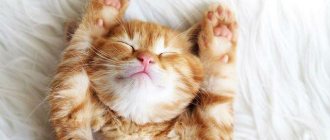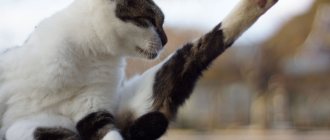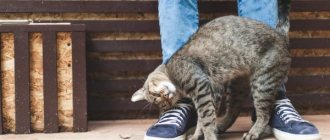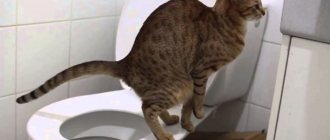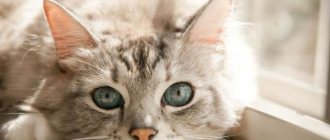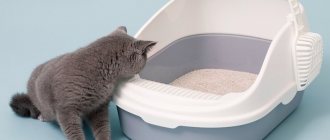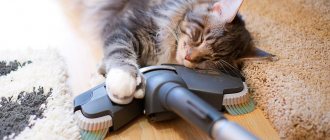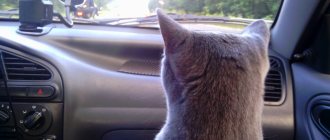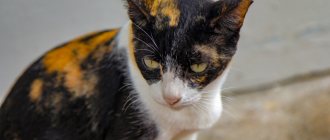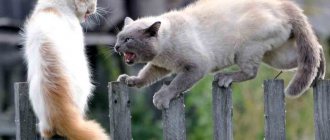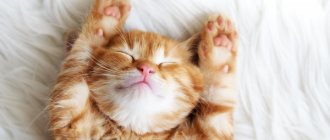One of the main organs in cats is the nose. Compared to humans, they have a sensitive and heightened sense of smell. This feature allows mustachioed pets to recognize, identify odors, and distribute them into separate elements for improved orientation in space. When a specific object is detected, the cat decides whether it is dangerous or tasty. A cat's wet nose is an indicator of its normal condition.
The importance of the olfactory organ for a cat and its care
Indeed, the condition of a pet’s nose is an indicator of its health and you need to pay due attention to its condition, because the effectiveness of the cat’s interaction with the outside world depends on it. Thanks to the moisture of their nose, the cat family:
- Captures odors better (domestic cats' sense of smell is 15 times more acute than that of humans).
- Determines the temperature of food.
- Helps to hunt.
- Heat exchange occurs, in particular cooling of the body;
- Warms and purifies the air.
If nothing bothers your pet, then its nose should be clean, smooth to the touch, cool and slightly damp.
The structure of a cat's nose
A cat's nose is designed to perform many tasks and functions.
In terms of its functionality, the nose is a complex mechanism and performs many tasks assigned to it by nature. In simple terms, the structure of an organ can be described in a few sentences.
- It consists of the body itself, which includes two passages, the so-called nostrils, separated from each other by a fragile partition - cartilage.
- These passages pave the way into a depth consisting of several corners in which the cat, if necessary, retains the scent he needs, first getting rid of other scents in order to highlight the main scent.
- The stored aroma molecules irritate the receptors associated with the olfactory part of the brain and odor recognition occurs.
A healthy cat's nose is moist and not dry. But the absence of these signs is not yet a fact of illness.
Strong and pungent odors
Too strong odors can injure your pet's nose.
By the way, a cat, due to its predatory nature, has much more of these receptors than a human.
Therefore, strong and pungent odors can injure your pet’s overly sensitive sense of smell.
Naturally, a cat’s nose performs more than just an olfactory function. It is also an important element in the mechanism of the respiratory system . Inhaling too humid, hot or cold air, the mucous membrane of this mechanism adapts it to the most comfortable temperature and normal functioning of the entire system.
Cat runny nose
Unlike a runny nose, the causes of a runny nose in a cat can be more complex. A runny nose, common in cats, is often a symptom of an upper respiratory tract infection. This may be due to bacteria and viral diseases. Upper respiratory tract infections are mainly the result of a strain of the herpes virus and chlamydia bacteria.
These types of upper respiratory problems occur regularly because cats are exposed to feline herpes. Like herpes in humans, the viral strain never leaves the body. This means that a viral outbreak can occur due to certain triggers throughout life. This is why even the most isolated cats can fall victim to an upper respiratory infection and subsequent runny nose with snot.
In cats, whose noses are often dry, a wet nose may indicate the onset of a cold. If your cat's nose is cool and wet to the touch, it can be difficult to determine whether an upper respiratory infection may be occurring. Watch for small changes because cats often hide health problems to avoid showing weakness to predators. Pay attention to your cat's nose when she lowers her head. If your cat has a cold, fluid will usually drip from the nose when the head is tilted.
Cats nose
Like a human's, a cat's nose has two nasal passages, between which there is a cartilaginous septum. The nose is one of the most important sense organs for a cat. Their sense of smell is several times more sensitive than ours. They are able to separate odors into their component components, and thus identify and locate objects and determine hazards.
© shutterstock
Normally, a cat's nose is cool and moist. During the day, it may change its condition slightly - become hot and dry. However, usually any deviations from the normal state are short-lived. If the nose is too cold or hot, too wet or dry for several hours or the whole day, you should pay closer attention to the cat's condition to track the cause of such changes. Veterinarian advice and assistance may be required.
The outer part of the nose should be even, smooth and have a slight shine. There should be no peeling or crusts on its surface. When such signs first appear, they should be eliminated on your own, but if they appear again soon, this indicates a health problem.
A wet nose means that the cat has no obvious health problems, at least those related to the respiratory system. But it is impossible to judge the absence of diseases only by the condition of the nose. Caring owners should monitor the pet's condition from time to time to make sure that the cat's nose is wet and she feels normal.
What could be a reason for concern?
By changing the temperature of the humidity of the nose, you can trace some of the processes occurring in the pet’s body. Sometimes this can be one of the signs that your pet is sick. It is necessary to understand in general terms when to worry and when not to.
The main symptoms at which the disease begins to progress:
- Goes to the toilet often or rarely.
- Diarrhea or bloody discharge.
- The cat is constantly in a tense state of stress.
- Excessive hair loss.
- Vomit.
- Deep breathing.
The temperature of the nose can change throughout the day, so there is no need to panic if your pet has just woken up and has a dry nose, as everything will be back to normal in a couple of hours. There is a scientific explanation for this: during sleep the animal is at rest, its body temperature rises, partial dehydration of the body occurs due to insufficient water, and after waking up all biochemical processes are restored.
A cold nose can be a sign of a disease, but it is also accompanied by other symptoms, such as diarrhea, vomiting, fever, weakness, and lethargy. In this case, it is recommended not to undertake independent treatment from the Internet, but rather contact a veterinarian for qualified help.
A cold nose in itself should not be a cause for concern , as it may be a completely normal reaction. The disease can be determined by observing the accompanying symptoms with a low nose temperature, for example colds:
- You should feel your ears; they may be hot.
- The cat eats little, is less mobile, lethargic.
- Snorts or sneezes frequently.
- High body temperature.
Body temperature is measured not by the animal's nose, but by a thermometer. The usual one used by people is suitable for this.
A cat has a hot nose - reasons
If you find a hot nose on your cat, do not rush to panic. Probably the reason for this was something from this list:
- the cat has recently woken up
- during sleep and immediately after, her nose remains warm and dry for some time; - the cat has experienced stress or has been actively playing
- a general increase in body temperature against this background also leads to a warming of the nose; - There is dry air in the room
- this problem is especially pressing in winter, when heating radiators are running, as well as in summer, when the air temperature is very high.
If the cat has no other signs of illness or illness, the condition of its mucous membrane and the outer surface of the nose will most likely return to normal after a short time. What does it mean if a cat has a hot nose for a long period of time (2-3 hours): there is probably a pathogenic bacillus in its body. In this case, pay close attention to see if your cat has any of the following signs, and if so, it’s time to see a veterinarian:
- refusal to eat, loss of appetite, or vice versa – insatiable appetite and thirst;
- high body temperature (above 40°C);
- dyspnea;
- runny nose, cough;
- vomiting, constipation, diarrhea;
- change in fur color, hair loss;
- drowsiness, apathy, anxiety, aggressiveness.
Hot nose in a cat after giving birth
Childbirth for a cat, like for a person, is a stressful situation. On the day the contractions begin, the cat becomes restless, walks around the room a lot, periodically trying on the prepared place - the “nest”. At the same time, the rectal temperature decreases by a couple of degrees. As the pain intensifies, her pulse and breathing rate increase. It is quite expected that a cat's initially cool or warm nose will gradually become hot. After labor is over, she will need some time to recover, after which the temperature of her body, nose and ears will return to normal.
If something went wrong during the birth of the kittens, there was an infection in the uterus or you see excessive bloody discharge, most likely her nose will be dry. In this case, a hot nose in a giving birth cat will indicate a general rise in temperature due to inflammatory or other painful processes in the body. To help her, you will need to contact a specialist.
The cat has a hot nose and is sneezing
Colds do not bypass our furry friends. Dry mucous membranes are not able to trap pathogens that penetrate the nasal passages, causing a response - sneezing. When a cat has a warm nose and is sneezing and snorting, he most likely has developed a cold. Additional symptoms are decreased activity and appetite, and a general increase in body temperature. Although sometimes sneezing is a sign of a foreign body getting into the nose. Or it could be a symptom of an allergy, such as to the chemicals you use when cleaning.
The cat is lethargic, the nose is dry and hot
Cats, like people, can freeze during a walk during the cold season or simply catch a cold in a draft. If you see that the cat has a hot and dry nose, he himself has become lethargic and apathetic, his appetite has decreased, this indicates the presence of a cold, viral or infectious disease. A competent veterinarian will be able to more accurately determine the disease and prescribe treatment.
What does it mean if a cat has a hot nose and diarrhea?
The cat is shaking with small tremors and a hot nose
When a cat has a warm nose (and even hot) and this is accompanied by trembling, the following conditions may be the cause:
Often, heavy breathing in cats, as in people, is associated with inflammation of the mucous membrane inside the nose and narrowing of the nasal passages. This happens with colds. There are other cases when heavy breathing is accompanied by the fact that the cat has a hot and dry nose, what does this mean:
- the animal probably has heart problems or pleurisy;
- perhaps the cat is simply scared, he is stressed, accompanied by a rapid heartbeat and rapid breathing;
- changes in breathing may be associated with overheating or hypothermia of the cat;
- in the presence of infections and viruses, diseases of internal organs, difficulty breathing becomes one of the indirect signs;
- with various injuries, especially if the chest is damaged, the animal’s breathing causes pain, it becomes heavy and uneven.
The cat has a hot nose and paws
We have thoroughly dealt with the question of why a cat has a warm nose. However, sometimes owners notice that their pet has hot paw pads and begin to panic. If we remember that cats have the only uncovered part of their body are their paws, and that their body temperature is normally 1-2 degrees higher than that of a human, then we can assume that in most cases the fears and fears of the owners are not well founded. It’s another matter if the animal’s general body temperature is higher than normal. Take a closer look at other symptoms of illness and, if necessary, contact a veterinarian.
Why does the cat have hot ears and nose?
When a cat has a warm, wet nose in combination with hot ears and this is not associated with banal overheating or stress, one of the following diseases can be suspected:
- inflammation;
- infection;
- gastrointestinal disease;
Possible accompanying symptoms when feeling unwell
Be that as it may, a dry and at the same time warm nose can be a sign of a disease that is important not to miss. Therefore, you should not postpone a trip to the veterinarian if other signs are still present:
- dryness is accompanied by the fact that the pet’s ears become hot;
- the animal lost its appetite, lethargy and apathy appeared. In this case, the pet does not react to familiar stimuli, and the temperature has risen to 38.5 °C;
- purulent or mucous discharge from the nose. Typically, such symptoms are accompanied by viral diseases;
- In addition to dryness, the cat exhibits distress and vomiting. Thus, the spout indicates dehydration of the body;
- eyes water, throat dries. A virus may develop or an allergy may occur. Although it may simply be a matter of dry air;
- the cat stopped drinking, her fur became dull and unkempt. This indicates a malfunction of the mucous membranes and dehydration of the body;
- the pet does not make contact, does not eat and sleeps little. This behavior indicates stress;
- increased hyperactivity, the mustachioed pet has become irritable and eats a lot. These signs may indicate neurosis. If the temperature rises to 39.5 °C, you should immediately contact a veterinarian.
Did you know? Nature has arranged it in such a way that cats with congenital anomalies of the nose or respiratory system die. And the reasons for this are not infections or a virus at all, but ordinary hunger. An animal deprived of its sense of smell is simply unable to track and catch prey.
How can you tell if your cat is sick?
A healthy animal has a cool, slightly moist nose. The disease usually manifests itself with an increase in temperature. But this doesn't always happen. Why does a cat have a cold and wet nose when he is sick?
It is impossible to determine the cause of the pathology by one sign, because such a symptom can occur:
- with decreased immunity;
- viral infection;
- cold;
- allergies.
© shutterstock
If a cat is sick, his behavior changes:
- appetite decreases;
- lethargy appears;
- he sneezes and snorts;
- often rubs his face with his paw.
The temperature may be elevated even if the cat has a cold and wet nose. A hot ear on the inside is a sign of hyperthermia. To clarify the indicator, a thermometer is used, as when measuring temperature in people.
It is difficult to determine the temperature of the earlobe, because it can be dry and warm after sleep, prolonged play, or during emotional excitement. However, if this condition persists for several hours and the cat is depressed, then it is necessary to show him to the veterinarian.
When to contact a veterinarian?
There are symptoms that require you to consult a veterinarian:
- Lethargy, passivity, malaise.
- Increased temperature of the nose, dryness.
- The color of the nose is pale and cold.
- The nose changed color to blue, red, yellow or white.
If one of the above symptoms is detected, there is no need to self-medicate ; you must contact a specialist, notifying him in detail about the cat’s symptoms. The veterinarian will collect the necessary tests, the results of which will help him determine the diagnosis and determine the course of treatment.
What are the signs that require contacting a veterinarian?
If the following symptoms are detected in a kitten, you should consult a veterinarian to identify the causes of your pet’s illness:
- malaise, lethargy, apathy;
- dry and hot nose;
- cold and pale nose;
- change in organ color (blue, yellowish, red, white).
The owner should know that a pale and cold organ in a kitten is a sign of:
- chronic illness;
- hypothermia;
- stress;
- low body temperature;
- poisoning;
- complete lack of appetite.
A white and warm nose is a sign of a disruption in the kitten’s circulatory system. The blue and hot organ talks about:
- heart failure;
- inflammation of the respiratory organs;
- oxygen starvation.
When a kitten has a hot and red organ, this is a sign:
- infectious disease;
- rhinitis;
- mechanical damage.
If a kitten has a hot, dry nose and warm ears, then this is not necessarily a sign of illness, because heat exchange has not yet been established in babies, and their body temperature is higher than that of an adult pet. This may be due to the work of the body and its protection from hypothermia.
Nutrition
A cold nose in combination with other symptoms is an indicator that may indicate a weakened immune system . Owners who don’t bother about their cat’s diet prefer to limit themselves to buying dry food. Dry food causes dehydration of the body, followed by failure of internal organs. It is recommended to dose the daily amount of dry food with regular homemade food. Cats are predators, so the body requires natural food - meat.
Proper nutrition helps a cat build normal organ functioning, increase resistance to diseases, withstand negative environmental influences and always be in good shape.
How to properly care for your cat's nose
To monitor your cat's health, you need to check the temperature of the nose with the back of your hand. This must be done carefully so as not to scare the pet.
It is necessary to be attentive, observe the behavior of the animal, monitor its appearance, provide adequate nutrition and good living conditions. Compliance with these requirements will help avoid the occurrence of diseases, as well as prevent serious consequences.
It is worth remembering that the health of the pet depends only on the owner. Only a healthy cat will be able to please and charge you with positive emotions.
Why does a cat have a wet nose: reasons
The nose is one of the most important sense organs for cats. Their sense of smell (like that of most animals) is tens of times more sensitive than that of humans. This makes it possible to identify and separate odors into their component elements, thus orienting themselves in space. Having identified this or that object, cats make a decision - to perceive it as dangerous, suspicious, tasty, and so on.
Normally, a cat's nose should be moist and cool. Depending on the emotional state, climatic conditions and other external factors, the animal may experience slight dryness. For example, when the cat is sleeping or dozing, and also within 30-60 minutes after waking up.
Is it normal for a cat to have a wet nose?
A cat's wet nose is mainly a byproduct of the environment, the animal's behavior, and its secretion levels. Some of the causes of excess moisture are completely natural, while others may be a symptom of a bacterial infection or viral disease. A wet nose is not a definitive sign that a cat is healthy or sick, so there are many other medical factors to consider.
If your cat's nose is warm and dry, you don't need to worry. Unless more alarming health symptoms appear, it is likely that the animal's nose has simply succumbed to environmental changes at this time. At that moment, you should monitor whether the temperature of the room, or perhaps the weather, has changed recently?
Condition of a healthy cat's nose
The nose of cats is a unique organ; its sense of smell is much stronger than that of humans. Animals constantly monitor its cleanliness so that their sense of smell, which is very important for them, does not decrease. Its front part is not covered with hairs and is called the lobe (or mirror). Due to the secretions of the mucous membrane, this organ is almost constantly wet and cool - this is its normal state.
If the lobe becomes dry and hot, this may be a sign of an elevated temperature in the cat and the onset of a disease. But this is not at all necessary; in healthy pets the mirror can also be hot. The color of the lobe may also change, for example, when it gets colder.
The respiratory humidity in cats can change several times a day. When they sleep and a few minutes after waking up, it is completely dry. Humidity also decreases after significant physical activity of the pet, especially if it is very active. The nose also becomes dry in a hot room or after the animal has suffered severe stress. In cats that like to be near heating appliances, this organ is hot and dry.
The mucus on your pet's nose helps him recognize any odors. And since cats do not have sweat glands, the mucus from the speculum helps maintain the normal condition of the entire body. With its mirror, the animal is able to determine the temperature of food without even touching it, using its organ as a thermometer.
When your nose is dry
A cat is an active creature that spends a lot of energy on somersaults, jumps, and deceptive maneuvers that require high energy costs. A healthy cat, with the habits of a night hunter and lover of walking, is obliged to compensate for hard work with a long rest. This is achieved by sleeping for many hours.
To be constantly alert, all organs and parts of the body must rest. Therefore, the nasal glands stop their secretory activity during rest. The result of this is a dry, warm nose. It seems hot to the owner because the intensity of metabolism, and ultimately the cat’s body temperature, is higher.
A similar phenomenon is observed after activity during hunting or play.
The wet state usually returns after half an hour, when the glands secrete a sufficient amount of mucus, or the cat fixes the problem with its own wet tongue. If after some time the nose remains hot and dry, it becomes necessary to conduct thermometry.
If your pet is active, cheerful, and playful, there is nothing to worry about. But when dryness is combined with lethargy and lack of appetite, it is necessary to find out the reason for what is happening.
Clean the nose with a cotton swab
How does a cat's nose work?
The nose of cats is a complex system, anatomically consisting of two passages separated by cartilage tissue. Inside, the cavity is “lined” with a mucous membrane, which is penetrated by many nerve endings and blood capillaries. The main role of the mucous membrane is to protect against household pollution, viruses and bacteria that can be transmitted from other animals and humans.
The mucous tissue also contains olfactory receptors, with the help of which, in fact, cats learn about the world around them. When you inhale, the air does not immediately enter the lungs, but is filtered by special pores and valves inside the nasal passages. Epithelial receptors “diagnose” odors received from the outside and give appropriate signals to the brain - there is danger ahead, hot food, the owner’s hands, an angry dog.
Also inside the nasal cavity there are special glands that secrete a mucous secretion, which protects the outer earlobe from drying out and cracking. Thanks to constant moisture, the animal can not only regulate its body temperature, but also significantly expand the range of its sense of smell.
Important: cats’ bodies are designed in such a way that they do not sweat naturally, and it is the nose that regulates heat exchange. It acts as a natural “cooler” in case of excessive activity or increased temperature outside in the summer.
Anatomy of a dog's nose and the secret of its moisture
A dog’s nose really should be constantly wet – and that’s why it should be cold . The secret of this feature of the animal’s body is that the skin on the dog’s nose is capable of secreting mucus - it has special glands, just like the mucous membrane inside the nasal cavity. Moisture of the nose is important for the dog, due to it it is possible to more effectively distinguish and identify odors, as well as the directions from which they come.
Dog nose
Fun fact : To determine the direction of the wind, a person can hold a finger in their mouth to moisten it and then lift it to feel the blow on their own skin.
Wet nose and sense of smell
The wet surface of the body actually becomes more sensitive in this regard. But this reason is not the only one that explains the wetness of a dog’s nose. It is also worth noting that the wet layer above the skin functions like a gas-liquid chromatograph, because the difference in the speed of molecules of substances that emit odor is recognized, and the dog can determine the directions and proximity of objects even better.
Interesting: Penguins - interesting facts, photos and videos
In dogs, not only the inside of the nose works - the outer covers of the thin and sensitive organ of smell also have a lot of functions.
In addition to the serous glands that secrete mucus, there are a lot of receptors on the dog’s nose. Once on a damp surface, odor particles are retained and the receptors have time to process them.
When to worry
One of the first symptoms indicating some kind of illness or illness in your pet is a dry and hot nose. However, do not forget that the body temperature of cats differs from the human norm and ideally equals 38-39 °C. The animal may be completely healthy, but the lobe will feel hot.
Signs indicating that the cat is still sick may include the following:
- Copious discharge flows from the nose, ears burn. Symptoms indicate the presence of an infection, such as rhinotracheitis or panleukopenia.
- Too wet nose, elevated body temperature, sneezing, lack of appetite. Perhaps there is a cold or acute respiratory viral infection.
- Copious discharge from the nasal cavity, containing blood or purulent inclusions. The possibility of some foreign object getting into the nasal passage cannot be ruled out.
- Excessive mucus discharge from the nose may be an allergic reaction to household chemicals, pollen, tobacco smoke, medications, or house or street dust.
- The lobe is very wet, and the cat itself sniffles heavily and breathes mainly through its mouth. Such symptoms may indicate the presence of a polyp and damage to the mucous membrane inside the nasal cavity.
- A wet and very cold nose indicates hypothermia or poisoning.
You can also judge the presence of health problems by the color of your nose. Thus, a bluish tint, as a rule, is a consequence of disorders in the cardiovascular system. Yellow almost always gives a “hint” to problems with the kidneys or liver. White indicates changes in the functioning of the circulatory system.
Video: why does a dog have a wet nose?
After watching this video, you will hear about interesting versions and reasons for your pet’s wet and cold nose.
Discussions about new causes of wet and cold noses in dogs continue among scientists to this day. However, the main thing is clear - this phenomenon is not a cause for concern. But if your pet has a dry nose, then under no circumstances ignore this factor and begin to solve this problem. If you know additional information regarding the topic discussed today, then share it in the comments.
Constant moisture of the nose and its color as an indicator of health
Stable moisture indicates good health of the pet. Based on the color of the organ, the condition of the patient is judged as follows:
- A smooth, cool, moist pink nose on a healthy cat.
- White indicates problems with the circulatory system.
- A red tint with pronounced signs of inflammation and excess mucus indicates rhinitis.
- Blueness of a wet or dry organ is the first sign of heart disease or lack of oxygen.
- Strong yellowness in humidity indicates problems with the liver and kidneys.
Nose care
A healthy cat handles its hygiene perfectly well on its own. As the air temperature rises, she begins to lick herself more actively and moisturize her nose. The same thing happens when some kind of debris, dust and other contaminants get on the earlobe. In the natural environment, the animal cleans its nose mechanically, in contact with trees, plants, grass, etc. Pets solve the problem by intensive washing.
The only exceptions are flat-faced breeds, in which, as a result of selection, the anatomical proportions of the skull have been changed. Due to a compromised nasal septum, these cats often develop crusts and excess mucus on the nose or near the nostrils. In such cases, you need to carefully remove scales and remaining snot with cotton swabs or swabs.
What is prohibited to do:
- Wipe your nose with damp alcohol wipes with antibacterial impregnation or perfumed fragrances. The mucous membrane may react with a severe allergic reaction.
- Use iodine or brilliant green for disinfection, especially if there are cracks and scratches on the nose. Actions can provoke burns and swelling, which, in turn, will make it difficult for the animal to breathe and put it under additional stress.
In any case, you should never self-medicate and at the first signs of illness you should consult a doctor for diagnosis and subsequent therapy.
Cases of non-dangerous deviations from the norm
- When Murka sleeps. After all, at this time she does not lick her muzzle, and the glandular cells hardly produce phlegm. The nose can remain dry and warm for another half hour or hour after sleep.
- Kittens, like... little guys, have unstable thermoregulation, so their body temperature is often elevated. For example, after sleep, games, meals, and even depends on the mood. It happens that the mother does not lick the baby thoroughly. Then the owner himself will have to wash it several times a day with a napkin with warm and boiled water.
- In winter, radiators in our homes both heat and reduce air humidity.
- Mild and short-term illness of the pet (overeating, excess hair getting into the stomach, etc.), stress or fear, pregnancy, childbirth, etc.
- Active and moving activities when the body warms up.
- Hot and muggy environment. But, after the end of unfavorable conditions, everything also returns to normal for the cat.
- The advanced age of the animal, during which metabolism slows down, and therefore... the nose is almost always dry and warm.
- So, for all these reasons (except for No. 7), the animal’s olfactory organ does not remain dry and warm for long. And if for a long time and, especially, other symptoms of trouble in the body are present, this sign portends serious illnesses. Which?
What should a healthy cat's nose be like: dry or hot?
Many cat owners are convinced that a hot and dry nose in an animal is the first and unmistakable sign that their pet is sick. This is a very common misconception - the temperature of the nose lobe does not reflect the general body temperature and certainly does not always signal illness. However, there is such a possibility; it needs to be checked and excluded immediately.
The cat has a cold and dry nose: what to do?
When a cat's nose is cold and dry, this is also a bad sign. This may happen for the following reasons:
- The cat has severe intoxication, regardless of its origin.
- During sepsis.
- If your pet is experiencing the thermal stage of some infectious disease.
- During intermittent fever. In this case, the animal’s temperature can periodically rise and then decrease.
- In each case, the nose becomes cold, as does the body of the animal. Most often, an unexpected drop in body temperature indicates that the animal’s brain does not have time to respond to thermoregulation.
Cold
- Sometimes this condition leads to the death of the pet. Immediately place the cat in a warm room (just make sure the room is not too hot), and call a veterinarian immediately. Self-treatment in such a situation can lead to big problems.
What kind of nose does a healthy cat have?
- What kind of nose does a healthy cat have? The nose of a pet that is absolutely healthy is always warm and slightly moist. Such signs are considered completely normal. But there are certain points that you should be aware of.
- Many cat breeds, for example, the Bengal cat , have a constantly dry nose. This is inherent in their nature. It is a dry nose that indicates that the animal is absolutely healthy.
- The Persian cat's nose, on the contrary, is always quite wet. This is because this breed has a slightly flattened muzzle and after the cat finishes washing itself, its nose remains wet.
- The humidity of the nose is often influenced by what exactly the pet eats. Many people claim that cats that eat only dry food have a moister nose than cats that eat natural food. This is because when eating dry food, animals need a large volume of water, and therefore they regularly wet their nose, when they drink water, they lick their lips.
Healthy nose
- A healthy cat, who is constantly active, has a normal psychological state, his nose is not very hot, almost the same as the whole body. It is moisturized, always has the same color, the skin around the nose is elastic and has a uniform structure.
- A cat's nose may be dry and warm according to your opinion, according to your personal feelings. The fact is that the temperature of cats is a couple of degrees higher than that of humans. A wet nose may always seem cold to you, and a dry nose may always seem hot.
A cat's nose is a mirror of health
Having discovered that their beloved cat’s nose has suddenly become hot and dry, most owners begin to worry whether the animal is sick. Don't rush to conclusions - a cute cat's nose may well deceive you.
The "mirror" of a cat's nose reflects the state of its health
You need to understand that your pet's nose can become moist due to two factors: due to the secretion of the nasal glands or simply due to the fact that the cat often licks it. This is how she regulates the operation of her individual temperature sensor, which is essentially the “mirror” of the nose. The sensitive skin on it and the epithelium in the nostrils are protected by physiological lubrication - if this does not happen, numerous receptors that are responsible for the sense of smell may be damaged. Therefore, prolonged dryness and elevated temperature of a cat’s nose is a signal of a malfunction in the normal functioning of its body.
Dog health and its nose – interesting video
There is an opinion that a dog's wet and cold nose indicates its health, while dryness and increased temperature of the olfactory organ may indicate illness. Sometimes this is true, although the nose cannot be considered an ideal indicator of health. Sometimes the nose is dry simply because the dog is hot - after some time its original condition will be restored.
Interesting: Why are elephants afraid of mice? Answer, photos and videos
But in other situations, in the presence of accompanying symptoms, a hot, dry nose can indicate a cold; in this case, sneezing and coughing are also observed. Once the dog gets better, its nose will return to normal. A dry nose can also occur with allergic reactions, with nasal pemphigus or injuries - in these cases it is advisable to consult a veterinarian.
If the dog is healthy, a dry nose indicates either dehydration or adverse weather conditions. Not only heat, but also frost leads to its drying out.
Why does your nose have to be wet?
The moisture of the nasal mirror is due to the fact that it contains many glands that secrete mucus. This wet substance covers the sensitive skin with a thin film. Single molecules of volatile substances enter the mucous membrane, reaching the olfactory receptor. That is why a cat’s sense of smell is almost as good as a dog’s and far exceeds a person’s olfactory abilities.
Cats are carnivorous predators, so a wet nose helps determine which way the wind is blowing and sneak up on the prey from the other side. Where the olfactory organ feels the chill is where the air moves from. The animal smells food very subtly. Therefore, his nostrils flare if the hostess begins to cut fish or meat. The cat smells something delicious. Caution helps the cat not to attack hot food. The nose senses danger from afar. If the olfactory instrument comes out of standing, the cat will not survive.
Cat licks the nasal speculum
Since the main component of any biological secretion is water, which has the ability to evaporate, the surface of the nasal speculum cools. Another function of a damp nose is thermoregulatory. A thick wool blanket protects well from cold weather, but does not allow the skin to cool down in hot weather. In addition, the animal warms up greatly while performing muscular work.
The absence of sweat glands forces the cat to fight overheating by evaporating moisture from the tip of the respiratory organ. To do this, the animal often licks the tip of its thermostat, replenishing the supply of constantly evaporating liquid.
Dry nose while sleeping
Treatment
Even an experienced breeder will not be able to diagnose a dangerous disease just because the cat’s nose has become hot and dry. It is easy to make a mistake in diagnosis even based on a combination of external signs.
The main thing that the owner of a sick animal should do before contacting a veterinarian is to measure the temperature of his pet. At home, its indicator will be more accurate than in the clinic, where the cat usually experiences additional stress, aggravating the patient’s condition.
What you can handle on your own
If nothing serious has happened, the owner can bring things back to normal himself - there are a lot of similar situations, we will describe only the most common ones.
Sensitive sense of smell
There is a very widespread opinion among experts in the field of felinology that if a cat could speak and had a human mind, it would certainly become a professional perfumer. This animal has a rather sensitive sense of smell, which is only slightly inferior to that of a dog. Why does my cat have a very wet nose? Otherwise, the animal simply would not have the opportunity to perceive the surrounding reality at the proper level.
If the cat did not have such an amazing sense of smell, it would not be able to hunt small rodents and birds. And although at home there is absolutely no need to maintain its natural talents, the animal still remains a predator with sharp claws and has quite strong jaws.
The cat has a warm nose, what should I do?
A pet's warm nose may not always mean the onset of a disease.
Surface temperature of the nose is important for preliminary examination and suspicion of the presence of a problem, but there are many reasons when hyperthermia is not a symptom of the disease.
When you shouldn't worry
Experts recommend checking the temperature of your ears along with your nose, but don’t panic if they are hot too.
- A cat's habit of sleeping curled up in a ball can play a bad joke on the pet owner. Securely covered with paws during sleep, these organs heat up and can be excessively hot to the touch.. Over time, this passes and the temperature drops to normal.
If your cat likes to sleep in a ball, the temperature of the nose may increase due to overheating.
- In addition, stressful situations can also cause a similar phenomenon. For example, simply transporting a cat in a special carrier can lead to this result.
- Changes in weather, sudden changes in temperature outside and indoors act as a certain stress for heat-loving cats.
Sudden changes in temperature outside can also cause a similar symptom.
It is important to remember that hyperthermia of the olfactory organ without any accompanying symptoms may simply be a reaction of the cat’s dissatisfaction to certain circumstances.
Causes for concern
Reasons for concern should arise when there are alarming, previously unusual signs of animal behavior.
Lack of interest in food, water and lethargy of the pet can alert the owner.
But also the presence of symptoms indicating that the pet is experiencing discomfort:
- loss of interest in food and water;
- insatiable appetite or thirst;
- breathing problems - shortness of breath;
- body hyperthermia above 40 degrees;
- presence of signs of respiratory diseases – cough, runny nose;
- increased salivation;
- there is pain in any area;
- signs of digestive system disorder - nausea, vomiting, constipation, diarrhea;
- violation of the act of urination;
- discharge mixed with blood or pus;
- sloppy appearance – dull or unkempt fur;
- hair loss;
- drowsiness, lethargy, weakness;
- the presence of blood or mucus in the urine or feces, change in the color of stool.
Such signs indicate the presence of pathology in the animal’s body, and you should immediately consult a doctor.
